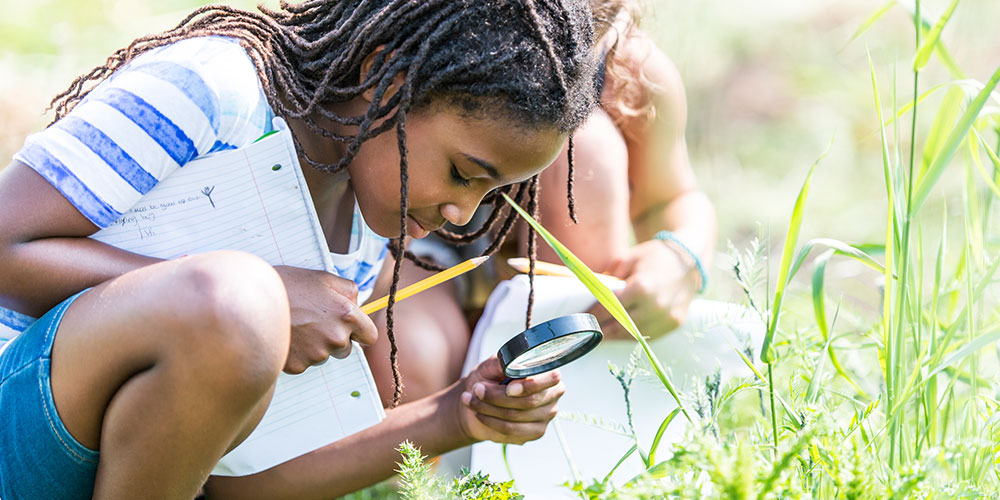Even the most brightly decorated classroom can’t replace the pleasures of the great outdoors. Vitamin D, freshly mown grass, sidewalks begging for chalk, the tweeting of birds and insects—what’s not to love? Education is about exploration, imagination, and experiencing the world in new ways, and taking your classroom outside once in a while is a great way to tap into these impulses.
Unexpected Benefits of Outdoor Education
For many students, the idea of class outside means no structure and running through the schoolyard with reckless abandon. But the truth is, outdoor education doesn’t mean shutting off your brain—quite the opposite. Being outside has the following benefits on students’ thinking and mental health:
- Cognitive engagement: Indoor classrooms are predictable: You sit in the same seat, everything is clean and organized, and you see the same posters and supplies along the walls. But outdoors, the environment is constantly changing, whether it’s shifting animals and weather or new and uneven terrain as students explore the grounds. As students take in all these new stimuli, their physical and cognitive skills are engaged. The CDC has found numerous connections between physical activity and increased academic performance.
- Enhanced perception: Practicing sensory awareness helps to exercise electrical patterns in the brain, which contributes to intellectual growth. Being outside gives students many opportunities to use their five senses to notice unexpected changes in their environment. Even small things—like changing focus from a far-off flying bird to a close-up crawling bug, or listening to close or distant traffic, or feeling different surfaces—can build students’ perception.
- Improved mental and physical health: The physical benefits of being outside are easy to spot: The sun provides vitamin D, which boosts the immune system and promotes bone and cardiovascular health. Being around plants also raises oxygen levels, which is important for brain function. But the health benefits go further than physical. According to School Outfitters, “Connectedness to nature also ushers in tremendous mental health benefits, including increases in the natural production of serotonin, the mood-elevating chemical that staves off depression. … The multisensory stimulation that students experience in nature also activates portions of the brain that are associated with positive psychological and emotional states.”
- Real-world thinking: We hear all the time about the importance of authentic learning and real-world connections. Even if your lesson doesn’t directly relate to what’s happening on your school grounds, being outside the classroom gives your students innumerable opportunities to observe the “real world” and the natural processes taking place all around them. Almost without thinking, students’ innate curiosity will be piqued, and they’ll subconsciously practice making observations and testing assumptions, without relying on a textbook or the Internet to tell them exactly what’s going on.
Activities for the Outdoor Classroom
Field trips to nature preserves and national parks are wonderful, but not always possible. Here are some ideas from Hands-On Teaching Ideas and Ecology Project International for outdoor activities you can conduct right on school property.
Gardening
Starting a classroom garden—even a small one that lives on your windowsill—has numerous academic and social–emotional benefits. Through the process of preparing the ground, planting crops, and weeding and watering, students will learn about nutrition; earth, physical, and life sciences; and social skills like collaboration.
Bug and Plant Hunts
Even if your school is in a more urban setting, it has an ecosystem all its own. If you’re familiar with the plants and animals in your area, you might make a list of them (with pictures) and challenge your students to a scavenger hunt. Or you might send your students out to take a biological survey, with the goal of finding as many different species as possible. You might even create a friendly competition and give a prize to the individual or group with the most discoveries!
Outdoor Art Exhibitions
For younger students, a bucket of chalk is plenty to get their creative juices flowing. You could also send students out with pencils and sketchpads to try to capture different scenes around the school grounds.
If you really want to get ambitious, you might talk to your school leader or community members about the possibility of creating a mural in a public space. Your students will be inspired by picking a topic, choosing the materials, and undertaking such a large artistic endeavor.
Photojournalism Explorations
If your students are a little older, you might consider letting them document their outdoor experiences with cameras. If your school doesn’t have cameras—or if you don’t want to let students take out their cell phones or tablets—you could use inexpensive disposable cameras. You can challenge students to take artistic shots, try to tell a story with pictures, or take their biological surveys to the next level.
Reading Adventures
Sometimes, struggling readers or tactile learners just need a change in venue. Let your students spread out to find the perfect reading nook outside, or gather everyone in a circle on the lawn for a unique reading experience. Being outside might also give you some more elbow room to act out reading different parts, and the new setting might even help to lower students’ inhibitions and let them become more absorbed in the story.
Cartography Practice
Activate your students’ spatial reasoning skills by challenging them to draw a map of your school grounds. Students will need to think through issues of distance, scale, and symbology as they decide how to best represent different landmarks and pathways around the school.
Public Speaking Exercises
Have your students practice being tour guides for the day! Sometimes, one of the challenges of public speaking is not knowing what to talk about. But the school grounds are a neutral topic that everyone can easily learn about. Challenge your students to make notes of prominent features and practice talking about them in front of an audience. Plus, if you’re a foreign language teacher, you might be able to incorporate vocabulary words into the assignment.
Community Service
Does your school have a creek or landscaping that’s in need of some TLC? Or maybe a fence that’s fallen into disrepair or an alleyway that’s become a dumping ground for debris? Give your students a chance to exercise their civic engagement by organizing a class cleanup project. Students can practice their project management and collaboration skills, while also contributing to their community!






